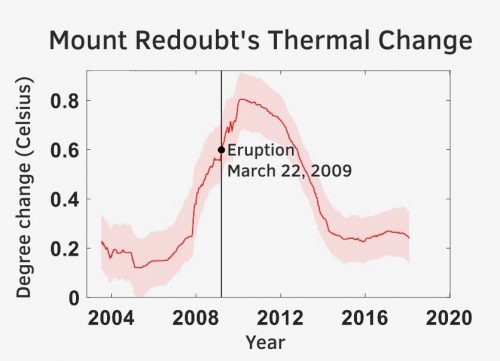Scientists have discovered previously hidden signs of thermal unrest in the years leading up to recent volcanic eruptions.
By Elisabeth Nadin, Ph.D., University of Alaska Fairbanks
Citation: Nadin, E., 2021, Getting Warmer — A Long Stride in Volcano Monitoring, Temblor, http://doi.org/10.32858/temblor.166
Natural disasters have a way of surprising us, and scientists are continuously seeking ways to minimize that surprise. Any clue to an impending earthquake or volcanic eruption could give communities much needed time to prepare.
To that end, Társilo Girona, of the Geophysical Institute at University of Alaska Fairbanks and Alaska Volcano Observatory (AVO), turned to satellite data to determine how radiant temperatures around volcanoes change before an eruption. He and his colleagues from the Jet Propulsion Laboratory of the California Institute of Technology recently published their findings in the journal Nature Geoscience. They analyzed 16.5 years’ worth of satellite-recorded radiance, or the heat (or light) emitted from the flanks of five volcanoes from around the world.
A meaningful trend
They found that each volcano had a different thermal history, but that each also showed a clear change in radiant temperature leading up to eruption. In the 2015 Calbuco eruption in Chile, Girona noted thermal unrest started around seven years before the eruption. In the 2009 Redoubt eruption in Alaska, the signal was three to four years.

The team focused on the change of the median radiant temperature on the flanks of volcanoes with different eruption styles, and found that NASA satellites Terra and Aqua were sensitive enough to measure a temperature difference of 1.8 degrees Fahrenheit (one degree Celsius) pre-dating an individual eruption.
While a 1.8-degree Fahrenheit (one degree Celsius) change might not seem like much, especially given uncertainties of up to 0.73 degrees Fahrenheit (0.4 degrees Celsius), the trend is more meaningful than any individual data point. Even accounting for the uncertainty in the measurements, “the change that we see with time is significant,” says Girona.
The diffuse thermal signal likely results from an underground water network beneath the volcanoes that moves the heat around. “We expect the ground to be warmer, especially if magma is close to the surface,” says geochemist Terry Plank of the Lamont-Doherty Earth Observatory at Columbia University. “The reason the signal is so small is that there’s a water system under the volcano and we’re looking at the heating up of the water system, not the magma directly. That’s why the thermal signal is subtle—the water spreads the heat around.”
Plank also thinks that the temperature on the ground could be much higher than the satellites detect.

More thermal signals
In summer 2021, AVO scientists aim to deploy temperature probes directly into the ground to track another signal noted in the study — movement of the heat source from the flanks of the volcano inward with time. “Measuring signals on the flanks is way safer than measuring in craters,” Plank says. The AVERT project, a collaboration with Columbia University, plans to monitor temperatures around Okmok volcano in the Aleutian Islands, Alaska. Okmok last erupted in 2008 and has been inflating since.
Girona and Plank both say they think that the results of the study hold great promise for volcano alerts. They say that although volcanoes can have many precursors, including increased earthquake activity and gas emissions, scientists don’t always know what they mean. In some cases, a volcano gives different warning signals over many years. Measurements of thermal unrest complement those other signals. In other cases, such as the 2014 eruption of Ontake in Japan and the Calbuco eruption, there are no other signals of impending eruption. The satellite measurements indicated radiant temperature changes began seven years before the Calbuco eruption, and two years before the Ontake eruption.
“The thermal signal is the most straightforward new phenomenon that we see before an eruption,” says Plank. “…it starts years before the eruption, which gives scientists plenty of time to expand monitoring on the ground.”

Girona says that temperature changes leading up to an eruption also seem to be a universal signal. “At this point, I haven’t found a volcano that doesn’t show this thermal unrest.” However, he says one shortcoming of the approach is that “we can’t detect thermal unrest that is occurring at timescales shorter than six months to one year, due to noise in the data.” Girona says that one of his goals is to develop the method to use in real-time volcano monitoring. “We can use this information to assess the alert level of a volcano, which is the step before forecasting.” He says he plans to analyze as many volcanoes as possible, and to extend the method to detect subtle, large-scale, thermal unrest on timescales from days to months.
References
Girona, T., Realmuto, V., & Lundgren, P. (2021). Large-scale thermal unrest of volcanoes for years prior to eruption. Nature Geoscience, 1-4.
- Earthquake science illuminates landslide behavior - June 13, 2025
- Destruction and Transformation: Lessons learned from the 2015 Gorkha, Nepal, earthquake - April 25, 2025
- Knock, knock, knocking on your door – the Julian earthquake in southern California issues reminder to be prepared - April 24, 2025
